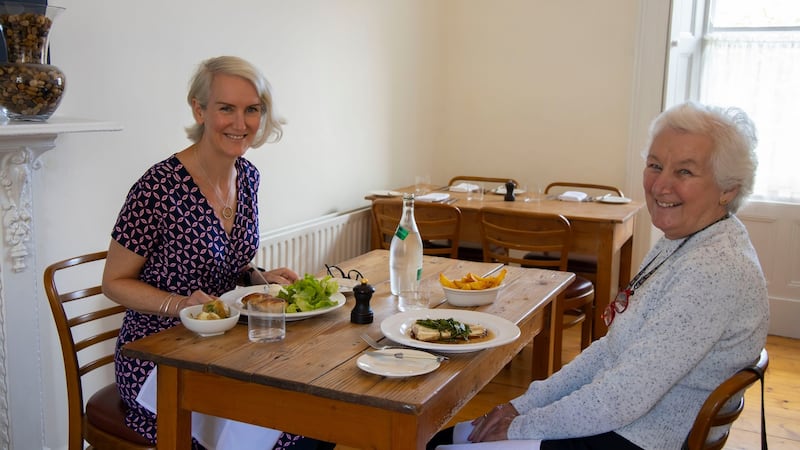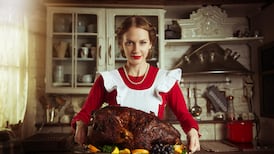I am steeling myself to be unsentimental. This is a grateful goodbye, after 10 years reviewing restaurants for The Irish Times. A new reviewer begins next week. But first, let’s celebrate the rediscovered joy of pulling up a chair to a table that someone else has wiped clean.
My world unfolded some of its limbs after slumber this week and wrapped me again in comforting rituals, with none of the hard questions that dropped like stones in the gut. Everything easy: Still or sparkling, medium or rare. “Would madam care for dessert?” Always.
Restaurants are not everyone’s idea of escapism but they have long been mine. A decade ago I clambered into a gúna, handed over the breastfed baby and jumped on my bike after an email from former Irish Times Magazine editor Patsey Murphy. She wondered would I like to take on the column “for a spell”.
Restaurants are all about role-playing. We know our lines, our places, sitting like well-behaved children, waiting to be dazzled or sated with lashings of buttery seasoned food
A decade has zipped by, probably the richest and most transformative in our short restaurant history. Rents tumbled and flavours soared, and then rents soared and the pressure cooker started jittering and hissing. Social media added its weird cocktail of sugary to toxic dopamine rush to the frenzy. Crowds thronged and the stars rained down. Every new opening seemed to land with an eye to the next shiny thing, hubris freeze-dried and tweezered onto a plate.
No one knew disaster was waiting, wheezing damply in the wings.
When the restaurant world went dark earlier this year, I thought a lot about the places that sat behind those shutters. There were the stages set for action like Las Tapas de Lola in my 2km zone, still resolutely set for service with polished glasses and cutlery as streets fell silent and shrank into themselves.
Restaurants are all about role-playing. We know our lines, our places, sitting like well-behaved children, waiting to be dazzled or sated with lashings of buttery seasoned food. Their return this week brings the world snapping back into a sort of focus, drawing clearer lines around things, formalising our eating again with the starter, main course, dessert formula or the high-wire tasting menu.
These are drawn more starkly as we come out of a time when boundaries blurred, when we asked who we were, ate muesli for dinner, juggled multiple identities – from teacher to support worker – burping and slurping our sourdough starters in a mass citizen-cheffing experiment that should bring an added level of appreciation for expertise and kitchen skills.
Some of us will hand our distressed palates back to the experts like home-dyed hair. In a world where every skill appears to be a YouTube video away, it’s easy to believe we can all be good at everything but after weeks we emerge grateful to admit that cooking can be harder than it looks.
Restaurants are about so much more than the food. The best front of house staff could give master classes in social distancing. They have all the spatial awareness and the nimble leap instincts of nervy cats
It was a lesson also that restaurants are about so much more than the food. There’s the ballet of service, the flat-shoed men and women who still practise the ancient and almost lost art of paying attention to people. They’ve been watching to see what you need and will ferry hand-hewn bowls of foraged greens or plates of crisp hot chips that have never come into contact with the wordless newsprint that is chip-paper. The best front of house staff could give master classes in social distancing. They have all the spatial awareness and the nimble leap instincts of nervy cats.
On Monday some doors opened again, people took deep breaths, some of them through masks, and watched the transformation of empty places into busy ones.
It was a quiet sort of beginning again. I didn’t hear any squeals or Dublin-Airport-at-Christmas scenes of pent-up grief and joy exploding. We’re still pent up. Because Covid-19 is still here and we’re trying to work around it and now, as rules get loose, that feels simultaneously freeing and terrifying. So there is something tentative about it all.
Kai, Galway
I stood outside Kai on Galway’s Sea Road on Monday trying to peer in the window without freaking out the people on table one, the largest scrubbed wooden table in this cafe and restaurant where groups regularly crammed in for long fish finger and cake-fuelled gatherings.
My middle son and I sat at the table where I last sat in October before a Galway Arts Festival interview with food writer Bee Wilson. We lunched with chef Jess Murphy in the lovely sea-soaked light that floods through the glass ceiling chatting easily about how we eat, what we love. There was lots of laughter. There was lamb stew with lovage.

So there was a sense of getting back to somewhere that had been lost and I soaked in the candles, the gleam of the glasses, the weightier, more polished cutlery, and the joy of other people around with their delighted “we don’t get out much” heads on them, a tentative uncurling of hope that sometime up ahead all will be well with the world, and a cough from the corner won’t send a tremor down everyone’s spine.
Family units have expanded to become work units. Jess and her husband, Dave, have been working with the team for weeks preparing for this. They can feed between a quarter and a third fewer people with social distancing in place. It’s less of a hit for them than for other places where tables were packed in tighter and the business models were based on a number of covers that is now at least halved. But with no overseas tourists and locals less keen or able to eat out as often, the small connected restaurant seems to be the one most resilient in this new landscape.
Beach House, Tramore
Two days later I'm in Tramore where the sugar-doughnut smell of a beach town hits you as soon as you step out of the car. The amusements are quiet but for one merry-go-round and a hot-air balloon ride that is lifting and falling too far away to see if there are any children on it.
Beach House could not have happened at a better time for Peter and Jumoke Hogan. The large, old townhouse came up for rent at the end of last year, and they decided to close their Dublin restaurant on Queen Street, Dublin 7 in December and take the plunge into a life with more breathing space.
During lockdown they planted the back garden, which had been laid out with a pond. In the raised beds their peas are scrambling up vigorously and producing the tiniest, sweetest peas that have barely swollen past the teardrop shape but are all the sweeter for it, that and the fact that they are their peas.
Peter wears a full blue face mask when he opens the heavy front door to us and brings up a pot from the garden to keep it propped open. It is testament to his friendliness that he can do a full smile with just his eyes. I’m with my mum so we’re both masked, ready to take the coverings off to eat and try to remember not to leave them on the table (so many biohazards now).
We could suspend them from one ear like strange earrings, but end up putting them on our laps for the duration.

After weeks of living with my own and others’ clutter, sitting in a clean, bare-bones room feels like a near-spiritual experience. Wide floorboards are varnished honey, chairs match and tables almost do. The walls are painted a chalky white and there’s a chalkboard over the fireplace where the mantle mirror would normally sit. Two windows on either end are half cloaked with net curtains that lift and drop like the place is breathing in the fresh-blown beach air.
The Beach House is all about the simplest of offerings: three starters, two mains and two desserts. There’s a summer vegetable soup. In Irish terms that means turnip is the base ingredient but don’t let that put you off. In Jumoke’s hands, that’s a creamy, light but comforting bowl, edged out with lemon and topped with chard, broadbeans and those magic little peas from their garden.
My plate of crab is pure sea salt, and sweetness set off with slices of pickled radish and a sharply dressed mizuna. There’s a main of plaice drenched in brown butter with new potatoes (Queens, natch) also drenched in butter. There’s crisply roast chicken and lettuce from the raised beds with chips that have a biscuit-crisp skin and a garlic aioli with so much garlic it’s nearly fiery.
There’s a milk-pale custard flecked with vanilla seeds with blousy raspberries, and a prune and almond tart with tangy crème fraiche that’s a rich vanilla colour. Chef Holly Dalton, home on a visit, is at another table and jokes how her parents had always told her Tramore was the place to open, and now they have been proved annoyingly right. Lunch comes to €85.50.
Bastion, Kinsale
We head to Kinsale for my last bite in Bastion, one of our new crop of Michelin-starred restaurants and one I've never visited. There's always a feeling of nervous stage fright before service at high-end restaurants, and during this reopening that can only be heightened. Everyone knows what to do, but now the stakes feel higher than ever.
It’s an €80-a-head tasting menu full of delights, not least the opener of a celeriac crisp topped with cubes of the lovely vegetable and a brioche rectangle so delicate its surface tastes like the crispy bits on the outside of a fried egg. There’s a pea and mint soup that’s exquisite in flavour and in looks, monkfish in a ginger broth combining comfort with fine cooking. A treacle butter is basically caramel on Guinness sourdough, and caramelised onion butter riffs on more brioche.
A place like Bastion gives spine to the slogan they've put up in the town about Kinsale coming back stronger. This level of cooking will bring visitors in our staycation summer
Tender-stem broccoli with ricotta and lemon butter is a delight and there’s cured prawn with a fiery horseradish cream and a soothing dill oil. Suckling pig has been slow-cooked and threaded to sit under a lid of crisp crackling with compressed nectarines for a fancier-than-apple fruit partner.
Passion fruit mousse is classic French high-art pastry cheffing where it all looks like sugary meringue and then surprises you with a sting of fruity tartness instead.
A place like Bastion in the quiet street gives spine to the slogan they’ve put up in the town about Kinsale coming back stronger. This level of cooking will bring visitors in our staycation summer. They will have better meals than we would find in the tourist traps of Europe and help to pack ballast into the ships of our homegrown talent for any further storms ahead.
What next?
And so it ends. One of those tough questions I grappled with during lockdown was what to do next. I’m not sure the world needs more opinions and it’s time to retire mine.
This is my last outing for The Irish Times restaurant review, a 10/10 mark for all three venues, the never-before-given ranking. The column continues with a fresh voice, and you will be in excellent hands.
I’m going backstage to look at our food system, using what look like worn-out tools of journalism, asking people questions to find out information rather than assuming I know the answers. I’ll be writing pieces trying to figure out what’s happening in bubbles outside of my own, avoiding the temptation to divine it from the hot and heavy vibrations of the vocally vehement on social media.
Along with historian and Irish Times columnist Juliana Adelman, we’ll be hearing from a wide range of voices on the theme of food and home on season two of The Comfort Feed podcast.
Thanks to all the people who fed me, the kitchen porters who rinsed plates, scrubbed out pots, cleaned the oil filters and emptied the waste buckets, the chefs and cooks who grudgingly took the criticism and thanked me for the praise
And there's another tendril of newness branching alongside that. I'm hanging up my dinner fork but deploying a larger one to plant trees in people's gardens, which will hopefully seed more and different kinds of planting in green-starved urban areas like my own neighbourhood in the south inner city. It's a project with my friend Ashe Conrad-Jones called Pocket Forests and you can read more about it, or even get involved, here.
Thank you to everyone who read and responded to the column over the past decade (even the trolls who hated what I did, but most of all seemed to hate the fact that I wasn’t a man). Thanks to the formidable girl gang of talented editors who whipped it into shape: Patsey, Orna, Rachel, Ciara and Marie-Claire, and to my witty and always oven-ready crew of dining companions, especially Maria of the fifth best dress who we loved and lost. There are two columns where she was beside me and there should have been many more.
Thanks to all the people who fed me, the front of house staff who pretended not to recognise me or plain didn’t recognise me, the kitchen porters who rinsed plates, scrubbed out pots, cleaned the oil filters and emptied the waste buckets, the chefs and cooks who grudgingly took the criticism and thanked me for the praise. That was your work, I always replied. If it wasn’t good, I wouldn’t have said so.



















